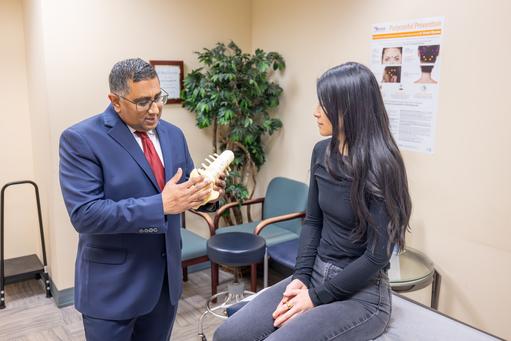Tag

Vertrae®: Kamal Woods, MD, MBA, FAANS
Vertrae®: Kamal Woods, MD, MBA, FAANSAbout Vertrae® Board-certified neurosurgeon and neurological spine surgeon Kamal Woods, MD, MBA, FAANS, is co-founder of Vertrae® in Miamisburg, Ohio. As a renowned neurosurgeon, Dr. Woods is proud to provide personalized care, just for you. Dr. Woods earned his medical doctorate (MD) from Loma Linda University School of Medicine in California. Upon graduating, he completed his internship in general surgery and residency in neurological surgery at Loma Linda University Medical Center. He then pursued his minimally invasive and complex spine fellowship at Cedars-Sinai Medical Center in Los Angeles. He recently completed his Master of Business Administration at Johns Hopkins Carey School of Business in Baltimore, Maryland.
Phone Number:
+1 844-255-2225
Business Hours:
Monday: 8 am–5 pm
Tuesday: 8 am–5 pm
Wednesday: 8 am–5 pm
Thursday: 8 am–5 pm
Friday: 8 am–5 pm
Saturday: Closed
Sunday: Closed
view this profile

Sciatica is a common condition that causes pain, numbness, and tingling in the lower back, buttocks, and legs. The sciatic nerve runs from the lower back down through the hips and buttocks and into each leg. When this nerve becomes compressed or irritated, the resulting pain is known as sciatica. It is characterized by a sharp, shooting pain that radiates down one or both legs, making everyday activities like walking or sitting difficult.
What is Sciatica?
The sciatic nerve plays a crucial role in providing feeling and movement to the lower body. However, when it’s affected by problems like a herniated disc, arthritis, or excess bone growth, it can lead to pain and inconvenience, the hallmark symptoms of sciatica.
Symptoms of Sciatica
Sciatica often begins in the lumbar spine due to natural degenerative processes and can cause a range of painful symptoms, including:
- Discomfort typically starts in the lower back and can travel down to the buttocks, thigh, and calf.
- Sciatica pain intensity can vary from a dull throb to a sharp, shooting sensation.
- Sometimes, it feels like an electric shock down the leg.
- Certain actions like coughing, sneezing, or prolonged sitting can worsen symptoms.
- Sciatica usually affects one side of the body, causing asymmetrical symptoms.
- Sciatica brings not just pain but also sensory issues that add to the distress of the person suffering.
This might include feelings of numbness, tingling, or weakness in the affected limb, making it harder to use normally. It can be a strange contrast: while one part of the leg is in intense pain, another part feels oddly numb. This mix of sensations highlights the particular characteristic of sciatica, blending different feelings to contribute to your discomfort.
Read more: https://www.princetonbrainandspine.com/conditions/spinal/sciatica/
Princeton Brain, Spine and Sports Medicine
731 Alexander Rd #200,
Princeton, NJ 08540
Office tel: (609) 921-9001
Fax: (215) 741-3143
Web address: https://www.princetonbrainandspine.com/
Office location: https://www.princetonbrainandspine.com/locations/nj/princeton/
Our location on map: https://maps.app.goo.gl/eeozrju3JjgJUGmo8
https://plus.codes/87G789C7+W4
Nearby Locations:
Princeton Junction, Plainsboro Center, Princeton North, Lawrenceville, Clarksville
08536, 08540, 08550, 08648
Working Hours: Mon-Fri: 9am-5:00pm
Payment: cash, check, credit cards.
Directory:
Tags:

Artificial disc replacement, or disc arthroplasty, is an innovative surgical procedure to restore stability in the spinal column when cushioning discs between vertebrae have been damaged or deteriorated. Princeton Brain, Spine & Sports Medicine’s experienced neurosurgeons are fellowship-trained to perform this state-of-the-art procedure at leading affiliated hospitals in PA and NJ.
What Is Artificial Disc Replacement?
For years, the traditional treatment for herniated, damaged or degenerated spinal discs has been a procedure called spinal fusion, where two or more vertebrae are joined together to stabilize the spine and alleviate pain in the neck and back. This fusion of vertebrae results in a loss of spinal flexibility. With artificial disc replacement, the damaged disc is restored with an FDA-approved replacement disc consisting of two metal plates or two metal plates separated by plastic padding. The metal plates glide over one another and the plastic disc, restoring the natural function of the spine and preserving the patient’s ability to bend forward, backward and side-to-side.
Princeton Brain, Spine and Sports Medicine
731 Alexander Rd #200,
Princeton, NJ 08540
Office tel: (609) 921-9001
Fax: (215) 741-3143
Web address: https://www.princetonbrainandspine.com/
Office location: https://www.princetonbrainandspine.com/locations/nj/princeton/
Our location on map: https://maps.app.goo.gl/eeozrju3JjgJUGmo8
https://plus.codes/87G789C7+W4
Nearby Locations:
Princeton Junction, Plainsboro Center, Princeton North, Lawrenceville, Clarksville
08536, 08540, 08550, 08648
Working Hours: Mon-Fri: 9am-5:00pm
Payment: cash, check, credit cards.

Princeton Brain, Spine and Sports Medicine
Dr. Mark Robert Mclaughlin, MDAward-Winning Neurosurgery & Spine Care in New Jersey and Eastern Pennsylvania. Experience life-changing relief from brain, spine, and joint injuries with our best orthopedic spine surgeonstop neurosurgeons and sports medicine specialists. Customized to your unique needs, our expert team will guide you towards a rapid recovery and a pain-free life.
Proudly serving patients in NJ and PA for nearly 20 years, our practices are home to award-winning, patient-focused doctors. Beginning with a precise diagnosis, we focus on educating patients at every stage of treatment, providing the industry’s most advanced treatment technology, and a range of conservative and surgical options.
Our multi-disciplinary team of board-certified doctors has undergone extensive training in their respective areas, providing highly specialized treatments and customized therapies delivered with compassion.
Princeton Brain, Spine, & Sports Medicine accepts most major insurance plans. Call us today to schedule a consultation or learn more about our outstanding practice.
At our spine surgery and neurosurgery center, you can make use of the following procedures:
- Spinal surgery
- back pain treatment
- neck pain treatment near me
- sciatica treatment
- Herniated disc treatment
- Anterior lumbar fusion
Princeton Brain, Spine and Sports Medicine
731 Alexander Rd #200,
Princeton, NJ 08540
Office tel: (609) 921-9001
Fax: (215) 741-3143
Web address: https://www.princetonbrainandspine.com/
Office location: https://www.princetonbrainandspine.com/locations/nj/princeton/
Our location on map: https://maps.app.goo.gl/eeozrju3JjgJUGmo8
https://plus.codes/87G789C7+W4
Nearby Locations:
Princeton Junction, Plainsboro Center, Princeton North, Lawrenceville, Clarksville
08536, 08540, 08550, 08648
Working Hours: Mon-Fri: 9am-5:00pm
Payment: cash, check, credit cards.
Our social links:
https://www.facebook.com/BrainSpineMD/
https://www.linkedin.com/in/mmclaughlinmd
https://www.linkedin.com/company/princeton-brain-&-spine-care/
https://www.instagram.com/brainspinesportsmed/
https://www.youtube.com/@brainspinemd726
https://www.pinterest.com/princetonbrainandspine/
https://www.yelp.com/biz/princeton-brain-and-spine-princeton-2
https://www.tiktok.com/@princetonbrainspine
Find us at: https://www.doximity.com/pub/mark-mclaughlin-md
View other locations Princeton Brain, Spine and Sports Medicine has been mentioned
https://birdeye.com/princeton-brain-spine-and-sports-medicine-157868801602816
https://www.bbb.org/us/nj/princeton/profile/neurosurgeons/princeton-brain-spine-0221-90191346
view this profile
Directory:
Tags:

Proudly serving patients in NJ and PA for nearly 20 years, our practices are home to award-winning, patient-focused doctors. Beginning with a precise diagnosis, we focus on educating patients at every stage of treatment, providing the industry’s most advanced treatment technology, and a range of conservative and surgical options.
Our multi-disciplinary team of board-certified doctors has undergone extensive training in their respective areas, providing highly specialized treatments and customized therapies delivered with compassion.
Princeton Brain, Spine, & Sports Medicine accepts most major insurance plans. Call us today to schedule a consultation or learn more about our outstanding practice.
Princeton Brain, Spine and Sports Medicine
731 Alexander Rd #200,
Princeton, NJ 08540
Office tel: (609) 921-9001
Fax: (215) 741-3143
Web address: https://www.princetonbrainandspine.com/
Office location: https://www.princetonbrainandspine.com/locations/nj/princeton/
Our location on map: https://maps.app.goo.gl/eeozrju3JjgJUGmo8
https://plus.codes/87G789C7+W4
Nearby Locations:
Princeton Junction, Plainsboro Center, Princeton North, Lawrenceville, Clarksville
08536, 08540, 08550, 08648
Working Hours: Mon-Fri: 9am-5:00pm
Payment: cash, check, credit cards.


Dr. Mark Robert Mclaughlin, MD
NeurosurgeonTo me, it was never a question of whether I would become a doctor but what area of medicine I’d choose. My grandfather, my idol, was a doctor in West Orange, New Jersey, for more than 50 years. As a kid, I followed him around constantly, and sometimes even carried his medical bag on house calls.
But when I entered college, I opted to major in philosophy, rather than follow the conventional pre-med track. My interests spanned beyond medicine. And, ultimately, I thought if I could think, speak, and write clearly, I’d be a better doctor.
While I’ve always considered myself an avid student, and still do, much of what I’ve come to understand about life I’ve learned on the wrestling mat. I was a Division I wrestler in college, and one of my proudest achievements was being inducted into the National Wrestling Hall of Fame in 2016.
For the better part of the last 20 years, I’ve coached 8- to 12-year-olds with the Princeton Wrestling Club in the town where I live. And five years ago, I helped launch Trenton Youth Wrestling, a program that each year enables 200 girls and boys from the city’s public schools to learn about and compete in the sport.
I’ve remained involved in wrestling because I believe its principles can help shape the trajectory of a child’s life. That’s what happened to me. I credit wrestling and an inspiring coach early in my life with giving me the mental and physical tools to do my best, on the mat and in the operating room. Wrestling taught me the importance of perseverance and gave me the fortitude to achieve a successful career, from pursuing a challenging residency under Dr. Peter Jannetta, the father of modern neurosurgery, to surrounding myself with some of the brightest minds working in the field today.
In recent years, I’ve settled into a slightly less prominent role within our practice so that I can devote more time to my patients. I continue to focus on cervical spine surgery, which has been revolutionized by the M6-C artificial cervical disc replacement. Designed to restore the natural range of movement to the spine, the M6-C disc is intended as an alternative to cervical fusion. Patients once crippled by pain who’ve undergone the procedure are consistently regaining a sense of normalcy in their lives.
My practice welcomes referrals for most brain and spine disorders, and we accept most major insurance providers, as well as Medicare.
Princeton Brain, Spine and Sports Medicine
731 Alexander Rd #200,
Princeton, NJ 08540
Office tel: (609) 921-9001
Fax: (215) 741-3143
Web address: https://www.princetonbrainandspine.com/
Office location: https://www.princetonbrainandspine.com/locations/nj/princeton/
Our location on map:
https://maps.app.goo.gl/eeozrju3JjgJUGmo8
https://plus.codes/87G789C7+W4
Nearby Locations:
Princeton Junction, Plainsboro Center, Princeton North, Lawrenceville, Clarksville
08536, 08540, 08550, 08648
Working Hours :
Mon-Fri: 9am-5:00pm
Payment: cash, check, credit cards.
view this profile

Low Back Pain and the global spine industry
Created by: HealthPadThis is a series of seven Commentaries on Low Back Pain and the global spine industry. They are not meant to provide “answers”, but to stimulate strategic thought and discussion.
Happy reading!
Directory:
Tags:

- Low back pain and the global spine industry -
The spine market and smarter diversity and inclusion policies Spine companies are predominantly manufactures led by White males who find themselves on the cusp of a transformation driven by the continued convergence of the physical and digital worlds, slowing traditional Western markets and growing emerging markets, and an increasing need to provide patients with the best outcomes at the lowest cost. This raises the bar for spine companies to demonstrate differentiated clinical and economic value. Over the next five years, the spine market is likely to face disruptions and opportunities that impact its core and emerging businesses. Industry leaders are tasked to discover ways to own their disruptions and find solutions to challenges associated with change. Given the projected nature and speed of this transformation, spine leaders’ quest for answers is unlikely to be satisfied by pursuing business as usual. To benefit from the opportunities presented by market challenges, industry leaders will need to recruit new talent with capabilities and competences relevant to an evolving ecosystem. Smarter and more aggressive diversity and inclusion policies, as part of a wider environmental, social and governance (ESG) focus, will be essential to stand a chance of hiring such talent. Environmental, social and governance issues
Environmental, ‘E’ issues, include the energy a company consumes, the waste it discharges, the resources required to address these matters and the impact ‘E’ questions have on people (e.g., radiation emissions). Social, ‘S’ issues, include a company’s diversity and inclusion policies. ‘S’ emphasises the fact that companies operate within a broader diverse society and addresses an enterprise’s relationships with people, institutions, and the communities where it does business. Governance, ‘G’ issues, represent the internal processes and controls an organization adopts to make effective decisions, comply with the law, and meet the needs of their stakeholders. In this Commentary
This Commentary focusses on the significance of social, 'S', issues to spine companies and suggests that adopting more aggressive diversity and inclusion policies could help them adapt their business models and strategies to become more clinically relevant and commercially successful in a rapidly changing ecosystem. Changing emphasis
Historically, ESG issues have been of secondary concern to corporate leaders and investors, but this has changed because ESG matters can provide insights into factors that impact on a company’s financial performance and thereby inform investment decisions. In recent years, institutional investors and pension funds have grown too large to diversify away from systemic risks, which has obliged them to consider the ESG impact of their portfolios. The possibility of commercial enterprises being held accountable by shareholders for their ESG performance puts pressure on managers to prioritize such matters. Already, public companies in the US are being encouraged to: (i) publish statements of purpose, (ii) provide investors with integrated financial and ESG reports, (iii) increase the involvement of middle managers in ESG matters, (iv) invest in robust IT and data management systems, and (v) improve internal practices for measuring and reporting the ESG impact on financial performance. ESG issues and spine companies
A spine company’s environmental ‘E’ footprint is comprised of instruments and devices, which have a variety of impacts and lifecycles. For example, imaging and guidance equipment eventually becomes electronic waste, surgical instrument sets require sterilisation before reprocessing and infected single-use devices add to recycling challenges.
|
|
|
|
|
|
|
|
|

|
Directory:
Tags:

|









